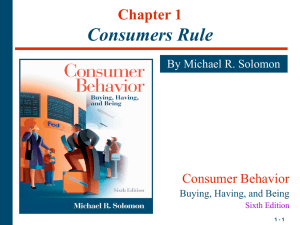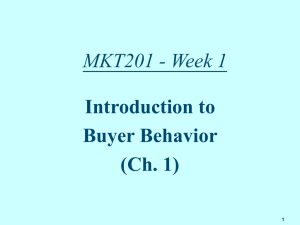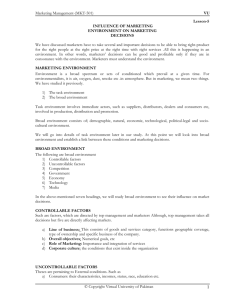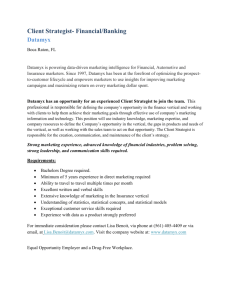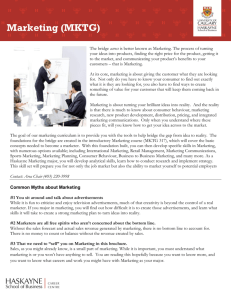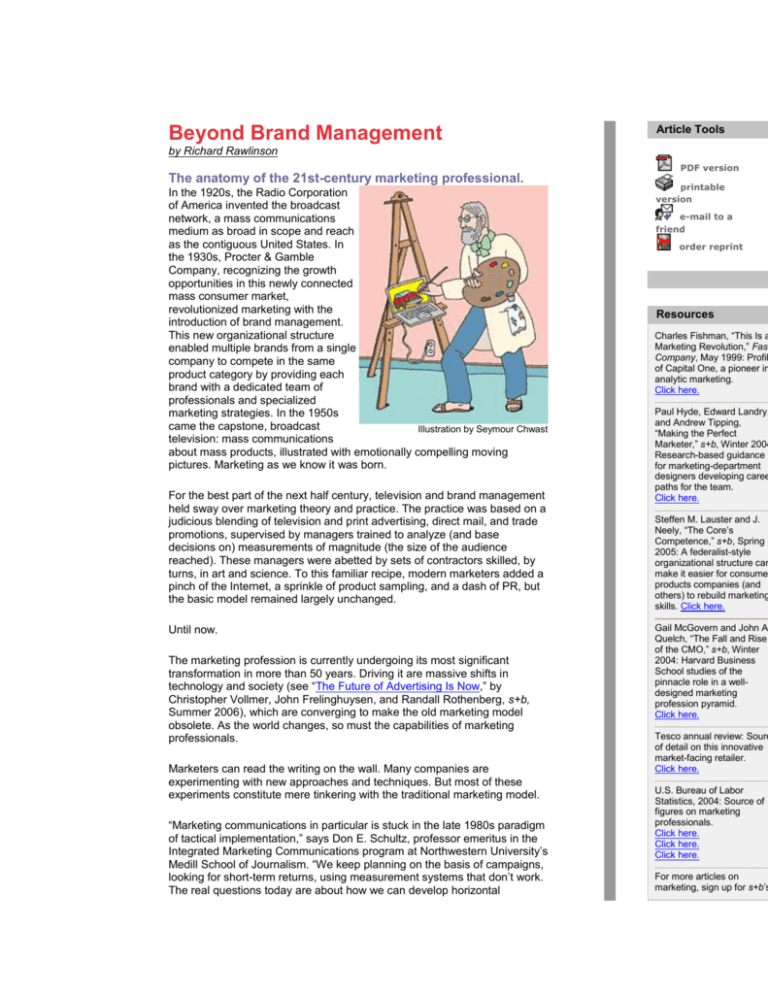
Beyond Brand Management
Article Tools
by Richard Rawlinson
PDF version
The anatomy of the 21st-century marketing professional.
In the 1920s, the Radio Corporation
of America invented the broadcast
network, a mass communications
medium as broad in scope and reach
as the contiguous United States. In
the 1930s, Procter & Gamble
Company, recognizing the growth
opportunities in this newly connected
mass consumer market,
revolutionized marketing with the
introduction of brand management.
This new organizational structure
enabled multiple brands from a single
company to compete in the same
product category by providing each
brand with a dedicated team of
professionals and specialized
marketing strategies. In the 1950s
came the capstone, broadcast
Illustration by Seymour Chwast
television: mass communications
about mass products, illustrated with emotionally compelling moving
pictures. Marketing as we know it was born.
For the best part of the next half century, television and brand management
held sway over marketing theory and practice. The practice was based on a
judicious blending of television and print advertising, direct mail, and trade
promotions, supervised by managers trained to analyze (and base
decisions on) measurements of magnitude (the size of the audience
reached). These managers were abetted by sets of contractors skilled, by
turns, in art and science. To this familiar recipe, modern marketers added a
pinch of the Internet, a sprinkle of product sampling, and a dash of PR, but
the basic model remained largely unchanged.
Until now.
The marketing profession is currently undergoing its most significant
transformation in more than 50 years. Driving it are massive shifts in
technology and society (see “The Future of Advertising Is Now,” by
Christopher Vollmer, John Frelinghuysen, and Randall Rothenberg, s+b,
Summer 2006), which are converging to make the old marketing model
obsolete. As the world changes, so must the capabilities of marketing
professionals.
Marketers can read the writing on the wall. Many companies are
experimenting with new approaches and techniques. But most of these
experiments constitute mere tinkering with the traditional marketing model.
“Marketing communications in particular is stuck in the late 1980s paradigm
of tactical implementation,” says Don E. Schultz, professor emeritus in the
Integrated Marketing Communications program at Northwestern University’s
Medill School of Journalism. “We keep planning on the basis of campaigns,
looking for short-term returns, using measurement systems that don’t work.
The real questions today are about how we can develop horizontal
printable
version
e-mail to a
friend
order reprint
Resources
Charles Fishman, “This Is a
Marketing Revolution,” Fast
Company, May 1999: Profil
of Capital One, a pioneer in
analytic marketing.
Click here.
Paul Hyde, Edward Landry,
and Andrew Tipping,
“Making the Perfect
Marketer,” s+b, Winter 2004
Research-based guidance
for marketing-department
designers developing caree
paths for the team.
Click here.
Steffen M. Lauster and J.
Neely, “The Core’s
Competence,” s+b, Spring
2005: A federalist-style
organizational structure can
make it easier for consume
products companies (and
others) to rebuild marketing
skills. Click here.
Gail McGovern and John A
Quelch, “The Fall and Rise
of the CMO,” s+b, Winter
2004: Harvard Business
School studies of the
pinnacle role in a welldesigned marketing
profession pyramid.
Click here.
Tesco annual review: Sourc
of detail on this innovative
market-facing retailer.
Click here.
U.S. Bureau of Labor
Statistics, 2004: Source of
figures on marketing
professionals.
Click here.
Click here.
Click here.
For more articles on
marketing, sign up for s+b’s
integrating processes and systems that work across disciplines, not just
across communication formats. We need some new concepts and new
approaches, not just rehashes of what we have been doing for the past 75
years.”
The transformation of media and markets has profound implications for the
way in which marketing is organized, the skills and outlook required of
professional marketers, and the types of training that marketers will need.
Some features of the new professional model for marketers are already
clear:
• More Diverse Skills. Marketing teams increasingly will address a broad,
complex agenda for consumer engagement, through a wide range of
communications media, including electronic, experiential, and nontraditional
channels. Success will mean blazing new career paths that combine the
sophisticated quantitative skills and the leadership ability needed to
supervise teams working in multiple, rapidly changing markets, with
traditional creative and management capabilities.
• Entrepreneurial Aptitude. The typical business marketing career has
attracted gregarious people who operate comfortably within a familiar
professional culture with well-defined techniques. But now marketers must
not just select and purchase proven instruments. They must envisage,
shape, and develop new tools for designing and engendering more effective
consumer connections. This demands openness to experimentation, an
inclination toward pioneering, and an ability to integrate marketing with
strategy as never before. The new marketing team must do this while
honing the number-crunching analytical ability that is needed to justify and
fine-tune new strategies.
• In-sourcing the Marketing Value Chain. The new marketing organization
will start to reintegrate the marketing supply chain. For the first time in
decades, marketers will develop their own in-house, proprietary, and
custom media operations. This wave of in-sourced media will put a premium
on the marketing department’s ability to orchestrate a fluid marketing
system with some new actors — and to do without outsourced help when it
is faster and more effective to develop these tools internally.
The shape of the future of marketing is too novel and too important to be left
to traditional marketers. Just as P&G pioneered brand management for the
20th century, now is the time for marketers to reinvent their role — and to
shuffle the marketing team to do it.
Career Trailblazers
In the long period of incremental change since the arrival of commercial TV,
marketing careers followed well-trodden paths. New university graduates
with liberal arts or undergraduate business degrees trained for five or six
years with one of a few major companies, such as Procter & Gamble or
Unilever. They got broad cross-category marketing experience, often in an
international context. Working with outside advertising agencies, they
bought mass communications media, available to all competitors, on the
basis of syndicated research, which was also available to others for a price.
Advancing marketing professionals learned to choose and integrate outside
agencies into the marketing team, to interpret consumer insights from a
market research study, and, using those insights, to build a brand with TV
commercials, print ads, consumer promotions, and trade promotions. Thus
seasoned, in their 30s they became brand managers. In their 40s, they
might become general managers — or they might leap to the “agency side.”
This kind of career path established an industry-wide pattern: specialized
grooming for a role with familiar lines and a well-worn plot. (See Exhibit 1.)
RSS. Click here.
It also set a career trajectory that attracted people with energy and
commitment, as well as a strong focus on action, results, and achievement.
Their training helped marketers assess campaigns and pitches — for
example, from advertising agencies — and to relate them to mass data on
consumers and the market. But it did not attract or nurture abstract thinking.
The 20th-century marketers tended to prefer detail and structure to the
ambiguities and uncertainties of the new. They wanted (and knew how) to
get things done, and their goal was to manufacture marketing as efficiently
and as uniformly as they manufactured goods.
The capabilities required for marketing professionals in this century are
already very different. Today, marketers have to create and assess
business propositions built around seemingly polar opposites: vast
databases on the one hand, and marketer-to-individual-customer
interactions on the other. As Internet distribution of digital media moves
beyond text, static images, and sound to include the equivalent of cinema
and television, the range of media and consumer experiences is becoming
as limitless as the number of Web pages. The 21st-century marketer will
increasingly have to choose between investing in a music download site
and investing in a campaign that makes use of mobile messaging, or
between funding banner advertisements and funding a new video-ondemand service. Nobody yet really knows how to make all of these
decisions with consistent success. It will require a great deal of
experimentation and risk taking — qualities associated more with R&D than
with marketing.
Most contemporary marketers are not accustomed to shaping, producing,
and directly overseeing the media in which they place advertising. Yet those
are the skills that are most needed today. Just as Procter & Gamble was
active in the design and development of early TV programming, so
marketers in the current period of media and marketing flux must expect to
imagine, create, and finance new kinds of digital or interactive media and
the innovative new forms of advertising and marketing they engender.
Marketers, working inside consumer product and service companies, not for
ancillary suppliers, will be among those who invent the new programs and
formats that will be to the next few decades what soaps and sitcoms were
to the past: vehicles for capturing audience loyalty and imagination.
For a marketing professional, exploring and shaping this kind of newly
tailored consumer experience calls for much more than was ever required
by conventional selection and purchasing decisions. To develop, deliver,
and promote the new formats — today, it is Massively Multiplayer Online
Games and Internet Protocol Television; tomorrow, we can’t even begin to
guess — marketers will have to reengineer and reimagine the relationships
among all participants in the marketing chain. Alternatively, they will do it
themselves. Companies as disparate as P&G and the electronics retailer
Best Buy have already begun to bring the necessary capabilities in house.
Either approach requires a new combination of commercial
entrepreneurship, technological competence, strategy skills, and consumer
sensitivity.
Number-Crunching Creatives
Undoubtedly the most salient features of electronic media are the diversity
and differentiation they bring to the marketplace. Digital media excel in
selecting the “audience of one” (or, to be more accurate, in allowing it to
select itself) and tailoring offerings to these individual consumers. Thus, a
precise and highly tailored implicit contract is evolving between the
consumer, who grants access and time, and the marketer, who reciprocates
the consumer’s interest with responsiveness and opportunities for more
extensive dialogue, as well as with entertainment and information.
To conceive, evaluate, and invest in new commercial propositions that
engage audiences across many dimensions, marketers will be called upon
to make decisions that reflect broad marketing savvy, close awareness of
the product’s or service’s current position in the marketplace, and in-depth
knowledge of quantitative techniques and the capabilities of new
technology. Thus, one of the new marketer’s key skills is the ability to marry
fluency in higher mathematics and computer modeling to marketing flair and
creativity. Just as mathematics has revolutionized finance, it will now
invigorate the marketing field, as new models and algorithms are developed
to extract value from consumer and business databases, and to allow more
precise targeting of “hot” topics to each consumer.
The exploding availability of electronic consumer data makes marketing a
new frontier application for business mathematics. It is no wonder that Booz
Allen Hamilton’s ongoing research with the Association of National
Advertisers has found that 66 percent of senior marketers believe their
greatest need is to develop capabilities in consumer insights and return on
investment (ROI) analytics. The leaders that are doing so are outcompeting
their rivals. These leaders are not just Internet powerhouses such as
Google and Yahoo; they include innovative number-crunchers in retailing,
finance, and other industries as well.
Consider the capabilities that took the Capital One Financial Corporation
from its position as a spin-off of Signet Banking Corporation in 1994 to
being the 115th-largest company in the S&P 500 in 2005, with more than
$10 billion in revenues and 50 million customer accounts. Its credit-card
business is built on a foundation of minutely fine-tuned product
development, market testing, and analysis, all of it resting on a bedrock of
terabytes of customer data. “When we started this company,” Chairman and
Chief Executive Officer Rich Fairbank once told Fast Company magazine,
“we saw two revolutionary opportunities: We could use scientific
methodology to help us make decisions, and we could use information
technology to help us provide mass customization.”
Another leader — in an utterly different industry — is the global consumer
goods retailer Tesco PLC. Mining scanner data and personal data captured
through the company’s Clubcard program, Tesco’s marketers practice
intensive information analysis, cross-tabulating purchase data against the
information gleaned from customer responses and requests, and
distinguishing the “signals” of genuine indicators of customer purchase
potential from the “noise” all around them. Using this technology, Tesco’s
marketers have redesigned their traditional tools, like direct mail and
“mother-and-baby clubs,” tailoring hundreds of thousands of individual
messages to customers. In a supermarket industry characterized by
historically low margins and fierce competition, Tesco reported revenues in
2005 that rose more than 10 percent from the year before, to $46 billion,
with profits up 19 percent. More than 150,000 orders now come in weekly
via the Web.
Does this mean that tomorrow’s marketers must be rocket scientists,
cousins to the Ph.D.s who have long populated investment banks and the
obscure corners of the financial-services industry? Not at all. But the
pervasive disdain that many professionals express toward marketing
science to this day — recall advertising legend Bill Bernbach’s scornful
declaration that “advertising is fundamentally persuasion, and persuasion
happens to be not a science, but an art” — must give way to a more
nuanced understanding of the profession’s inherent, necessary crossfunctionality.
The most successful professionals will display an intense curiosity about
new approaches and tools, the ability to think in novel and creative ways, a
higher-than-normal inclination to experiment, and much greater tolerance
for ambiguity. These skills will be put to work as marketers evaluate
propositions, define their strategies for media and creative investment, and
devise new ways to engage with consumers in more intimate and effective
marketing dialogues. General Electric Company CEO Jeffrey Immelt has
stated that “sophisticated marketing” is now one of the company’s three
imperatives, along with risk taking and innovation. The next-generation
marketing team will itself embody all three of these qualities.
Sophisticated Integrators
A thoroughgoing change is also under way in the fragmented supply chain
that has come to characterize the marketing world. Over years of stability
and growth, marketing has subdivided itself into ever more finely granulated
specialties. A typical fast-moving consumer goods company orchestrates a
web of suppliers that includes advertising agencies, buying agencies,
creative specialists, direct-mail firms, and market researchers of all manner.
This proliferation of outsourcing has steadily grown since the rise of mass
television in the 1950s and 1960s. Many specialties have subdivided,
adding responsiveness to the marketing-services system, but also adding
many layers of complexity.
With the increased use of international marketing suppliers spread across
several continents, yet with media buying decisions often made in local
markets, the complexity has mushroomed. Supervising that huge extended
enterprise could be deemed the central skill of the hundreds of thousands of
men and women currently serving in marketing management roles. (In the
United States alone, 664,000 people were serving in sales, marketing,
advertising, promotions, and public relations management in 2004, the most
recent year for which figures have been published by the U.S. Bureau of
Labor Statistics. Broadcasting accounted for another 327,000 jobs. The
motion picture and video industries contributed 368,000 more.)
True, with so many participants, there are many springboards from which
new ideas and practices can take flight. Local experimentation often works.
But the complexity inherent in the system suppresses its ability to absorb
that experimentation or use it on a larger scale. That’s why it is so hard to
rewire an existing marketing strategy or move to a better approach,
especially internationally. Each component in the system — each local
agency, research supplier, or creative group — depends on others playing
their established roles in the ecosystem. Change for one implies change for
others. Yet with so much vested in the current ways of doing business, no
individual supplier or department can be sure that its individual change will
be met with complementary changes in the others — and few can (or
should) take the risks of changing their practices unilaterally. Thus, only a
radical approach to innovation, affecting many of the players at once, will
succeed.
For many, the solution will be reintegration. After years of outsourcing, that
won’t be easy or optimal. As Paul Bay, former director of consumer
communications at Levi Strauss, has commented: “Being ‘integrated’
means the creative agency thinks of the idea and everyone else executes it.
Changing that convention needs a lot of education. It will be very tough.”
Some of the giants of the marketing world have been the first to look
beyond the current system to create new vehicles for integrated marketing
supply chains. Strong retailers are a good example. They are the new
arrivals on the branding front lines, with much less vested in the traditional
marketing system. They have found it natural to do much of their marketing
themselves. Tesco bypasses large chunks of the conventional marketing
system in the U.K. and has integrated its market research and analytics
capability, which was formerly conducted by an independent firm. Other
retailers are reinventing media at the point of sale. Wal-Mart, for example,
has made a major commitment to in-store TV, creating a new medium
powerfully connected to the consumer shopping experience and to the
purchaser’s moment of decision.
In traditional marketing teams, the action-oriented, authority-driven mind-set
rules. Indeed, too often it squeezes out the more innovative dispositions
and the exploration and experimentation they bring. But the strategic
agenda for marketers has changed. Creative and commercial businesssystem perspectives must play a greater role in team composition, so that
companies can look up and down the value chain to imagine and
experiment with new ways of operating. As marketing teams gain diversity
and balance, team management in turn becomes more integral to marketing
effectiveness. It is thus crucial to have active and deliberate leadership
capacity on the marketing team.
It is tempting to think that only outsiders, in the form of small,
entrepreneurial upstart companies, can effectively tear down the
international marketing system. Yet the big consumer goods companies are
uniquely positioned to reinvent the marketing model for the 21st century.
Indeed, they and the large retailers are the only companies positioned to do
so. Only they can take responsibility for the system as a whole — and use
their spending to reshape it. Their money and leverage influence the whole
system.
These corporations also have the most direct and compelling need for the
system to perform. Unlike the specialized suppliers, they don’t have to
answer to any one client. This means they are less constrained than other
members of the system and are free to reassemble the pieces in new and
interesting ways. And some of the best are leaders in using their freedom
and power. The broader agenda being pursued by such companies as
Procter & Gamble, Capital One, Tesco, and Coca-Cola is symptomatic of
the change that will affect marketers across industry and geography. The
winners will be driven by their vigor and determination in reshaping the
marketing team. That’s the place for companies to start. New times call for
new capabilities, and for team structures that can win in an era of
technology, uncertainty, and change.
Reprint No. 06205
Author Profile:
Richard Rawlinson (rawlinson_richard@bah.com) is a vice president with Booz Allen
Hamilton in London. He focuses on the leadership agenda for consumer products,
telecommunications, and public-sector clients.
Page 1 2 3 4 5 All
This article is from Summer 2006
Click HERE to subscribe to strategy+business
Magazine || enews || Search and Browse || Press Room || Reprints || Subscriber Services || HOME ||
About s+b || Contact s+b || Advertise in s+b || Privacy Statement || Legal
©2006 Booz Allen Hamilton Inc. www.bah.com All rights reserved.
Contact Webmaster || Powered by Raven Creative, Inc.





